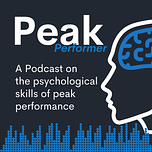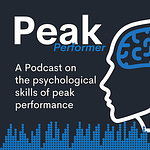In this podcast episode, I'm reading Chapter 3 of Stewart Cotterill's The Psychology of Performance and discussing the difference between self-confidence and self-efficacy. Throughout this reading, I interrupt the narrative to offer my input, clarity on certain aspects, and tips and advice on building up your sense of efficacy.
Chapter 3 of Stewart Cotterill's "The Psychology of Performance," titled "The Impact of Confidence on Performance," provides a comprehensive examination of how confidence influences performance across various contexts, including sports, business, and personal endeavours. This chapter highlights the multifaceted nature of confidence and its critical role in achieving peak performance.
Understanding Confidence
Cotterill defines confidence as a belief in one's abilities to achieve specific outcomes. This belief is crucial as it impacts several psychological processes essential for high performance, such as motivation, effort, and persistence (Bandura, 1997). The chapter differentiates between self-confidence and self-efficacy. Self-confidence is a broader belief in one's general capabilities, while self-efficacy is more specific, relating to the belief in one's ability to succeed in particular tasks (Bandura, 1986).
Sources of Confidence
Cotterill identifies several key sources of confidence, drawing on extensive psychological research:
Past Performance Accomplishments: Success in previous tasks enhances self-efficacy by reinforcing the belief in one’s ability to achieve similar outcomes in the future (Feltz, 2007). This is the most influential source of self-efficacy because it provides direct evidence of one’s capability.
Vicarious Experiences: Observing others, especially those perceived as similar to oneself, successfully performing tasks can boost an individual's confidence. This process, known as modelling, is powerful because it provides a comparative benchmark and inspires belief in one's own abilities (Schunk, 1987).
Verbal Persuasion: Encouragement and positive feedback from coaches, peers, and mentors can enhance an individual's belief in their capabilities. This source of confidence is effective because it can help individuals overcome self-doubt and focus on their strengths (Bandura, 1997).
Physiological and Emotional States: Positive physical states, such as feeling energetic and healthy, and positive emotional states, such as feeling calm and focused, can enhance self-confidence. Conversely, negative states can undermine confidence (Cotterill, 2018).
Enhancing Confidence
Cotterill outlines various strategies to build and maintain confidence, emphasizing the importance of a systematic and holistic approach:
Deliberate Practice: Deliberate Practice involves structured and purposeful practice aimed at improving performance. Ericsson et al. (1993) argue that this type of practice leads to the development of expertise, which in turn enhances confidence.
Cognitive Restructuring: This involves identifying and challenging negative thoughts and replacing them with positive and constructive thoughts. Techniques such as positive self-talk and affirmations are recommended to build a resilient mindset (Beck, 1976).
Goal Setting: Setting SMART goals (Specific, Measurable, Achievable, Relevant, Time-bound) provides clear benchmarks for success. Achieving these goals incrementally builds confidence as individuals see tangible evidence of their progress (Locke & Latham, 2002).
Overcoming Barriers to Confidence
Cotterill also explores common barriers to confidence, such as fear of failure and negative self-talk, and offers strategies to overcome these challenges:
Fear of Failure is a significant psychological barrier that can lead to avoidance behaviours and decreased performance. To reduce performance anxiety, Cotterill suggests focusing on the process rather than the outcome. Emphasising effort and learning rather than perfection helps individuals engage more fully and fear failure less (Sagar et al., 2010).
Negative Self-Talk, or internal dialogue that undermines confidence, can be countered with cognitive-behavioural techniques. By challenging negative thoughts and replacing them with positive affirmations, individuals can develop a more confident and optimistic outlook (Beck, 1976).
Practical Applications
Cotterill provides practical examples and applications of these concepts across different fields:
In Sports
Athletes can enhance their performance by building confidence through systematic training, visualization techniques, and receiving constructive feedback from coaches (Vealey, 2001).
In Business
Professionals can improve their confidence by setting achievable goals, seeking mentorship, and maintaining a healthy work-life balance to ensure positive physiological and emotional states (Luthans et al., 2007).
Conclusion
Chapter 3 of "The Psychology of Performance" underscores the critical role of confidence in achieving high performance. By understanding the sources of confidence and employing strategies to enhance it, individuals can significantly improve their ability to perform under pressure and achieve their full potential. Cotterill’s insights offer valuable guidance for athletes, performers, and professionals striving for excellence in their respective fields.
Learn The Psychology of Human Performance
References
- Bandura, A. (1986). *Social Foundations of Thought and Action: A Social Cognitive Theory*. Englewood Cliffs, NJ: Prentice-Hall.
- Bandura, A. (1997). *Self-Efficacy: The Exercise of Control*. New York: Freeman.
- Beck, A. T. (1976). *Cognitive Therapy and the Emotional Disorders*. New York: International Universities Press.
- Cotterill, S. (2018). *The Psychology of Performance*. Routledge.
- Ericsson, K. A., Krampe, R. T., & Tesch-Römer, C. (1993). The role of deliberate practice in the acquisition of expert performance. *Psychological Review*, 100(3), 363-406.
- Feltz, D. L. (2007). *Self-Efficacy in Sport*. Champaign, IL: Human Kinetics.
- Locke, E. A., & Latham, G. P. (2002). Building a practically useful theory of goal setting and task motivation. *American Psychologist*, 57(9), 705-717.
- Luthans, F., Youssef, C. M., & Avolio, B. J. (2007). *Psychological Capital: Developing the Human Competitive Edge*. Oxford: Oxford University Press.
- Sagar, S. S., Lavallee, D., & Spray, C. M. (2010). Why young elite athletes fear failure: Consequences of failure. *Journal of Sports Sciences*, 28(4), 423-435.
- Schunk, D. H. (1987). Peer models and children's behavioral change. *Review of Educational Research*, 57(2), 149-174.
- Vealey, R. S. (2001). Understanding and enhancing self-confidence in athletes. *In R. N. Singer, H. A. Hausenblas, & C. M. Janelle (Eds.), Handbook of Sport Psychology (2nd ed.)*. New York: Wiley.












Share this post